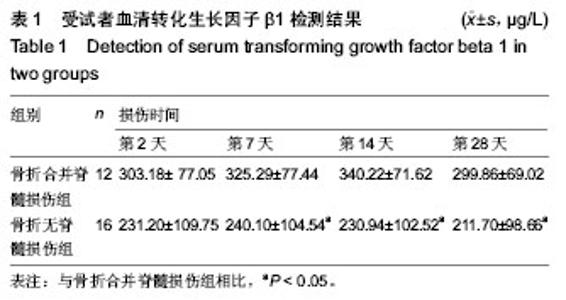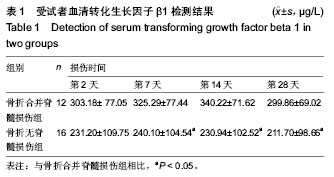| [1] Urakawa H, Tsukushi S, Hosono K,et al. Clinical factors affecting pathological fracture and healing of unicameral bone cysts. BMC Musculoskelet Disord. 2014;15(1):150-159.
[2] 邹平洲,曾炳芳,张先龙.血管内皮细胞生长因子在异体皮质骨移植修复骨缺损中的作用[J].中国修复重建外科杂志,2005,19(8): 593-596.
[3] Pountos I, Georgouli T, Henshaw K, et al. Release of growth factors and the effect of age, sex, and severity of injury after long bone fracture. A preliminary report. Acta Orthop. 2013; 84(1):65-70.
[4] Kaiser G, Thomas A, Köttstorfer J, et al. Is the expression of transforming growth factor-beta 1 after fracture of long bones solely influenced by the healing process? Int Orthop. 2012; 36(10):2173-2179.
[5] Estai MA, Suhaimi F, Das S, et al. Expression of TGF-β1 in the blood during fracture repair in an estrogen-deficient rat model. Clinics (Sao Paulo). 2011;66(12):2113-2119.
[6] Sarahrudia K, Thomas A, Mousavi M, et al. Elevated transforming growthfactor-beta 1 (TGF-β1) levels in human fracture healing. Injury. 2011;42(8):833-837.
[7] Ritz MF, Graumann U, Gutierrez B, et al. Traumatic spinal cord injury alters angiogenic factors and TGF-beta1 that may affect vascular recovery. Curr Neurovasc Res. 2010;7(4): 301-310.
[8] Servin-Trujillo MA, Reyes-Esparza JA, Garrido-Fariña G, et al. Use of a graft of demineralized bone matrix along with TGF-β1 leads to an early bone repair in dogs. Vet Med Sci. 2011; 73(9):1151-1161.
[9] Jiang SD, Yan J, Jiang LS, et al. Down-regulation of the Wnt, estrogen receptor, insulin-like growth factor-I, and bone morphogenetic protein pathways in osteoblasts from rats with chronic spinal cord injury. Joint Bone Spine. 2011;78(5): 488-492.
[10] Ng F, Boucher S, Koh S, et al. PDGF, TGF-beta, and FGF signaling is importantfor differentiation and growth of mesenchymal stem cells (MSCs): transcriptional profiling can identify markers and signaling pathways important in differentiation of MSCs into adipogenic, chondrogenic, and osteogenic lineages. Blood. 2008;112(2):295-307.
[11] Patil AS, Sable RB, Kothari RM. An update on transforming growth factor-β(TGF-β): Sources, types, functions and clinical applicability for cartilage/bone healing. Cell Physiol. 2011; 226 (12):3094-3103.
[12] Wang X, Chen W, Liu W, et al. The role of thrombospondin-1 and transforming growth factor-beta after spinal cord injury in the rat. Clin Neurosci. 2009;16(6):818-821.
[13] Kohta M, Kohmura E, Yamashita T. Inhibition of TGF-beta1 promotes functional recovery after spinal cord injury. Neurosci Res. 2009;65(4):393-401.
[14] Spencer RF. The effect of head injury on fracture healing: a quantitative assessment. Bone Joint Surg (Br). 1987;69(4): 525-528.
[15] Yang TY, Wang TC, Tsai YH, et al. The effects of an injury to the brain on bone healing and callus formation in young adults with fractures of the femoral shaft. J Bone Joint Surg Br. 2012;94(2):227-230.
[16] 王海龙,盛伟斌,徐韬,等.大鼠股骨骨折合并脊髓损伤模型的构建[J].中国组织工程研究,2014,18(18):2818-2823.
[17] De Gorter DJ, van Dinther M, Korchynskyi O,et al. Biphasic effects of transforming growth factor β on bone morphogenetic protein-induced osteoblast differentiation. J Bone Miner Res. 2011;26(6):1178-1187.
[18] Servin-Trujillo MA, Reyes-Esparza JA, Garrido-Fariña G,et al. Use of a graft of demineralized bone matrix along with TGF-β1 leads to an early bone repair in dogs. J Vet Med Sci. 2011;73(9):1151-1161.
[19] Buss A, Pech K, Kakulas BA, et al. TGF-β1 and TGF-β2 expression after traumatic human spinal cord injury. Spinal Cord. 2008;46:364-371.
[20] Yang L, Blumbergs PC, Jones NR, et al. Early expression and cellular localization of prion flammatory cytokines interleukin-beta, interleukin-6, and tumor necrosis factor-alpha in human traumatic spinal cord injury. Spine. 2004;29:966-971.
[21] Buss A, Brook GA, Kakulas B, Martin D, et al. Gradual loss of myelin and formation of an astrocytic scar during Wallerian degeneration in the human spinal cord. Brain. 2004;127: 34-44.
[22] Beloosesky Y, Weiss A, Hershkovitz A, et al. Serum transforming growth factor beta-1 post hip fracture repair in elderly patients.Cytokine. 2011;54(1):56-60.
[23] 曹新峰,陈德玉,赵定麟,等.大鼠脊髓损伤后转化生长因子β1 mRNA表达变化及甲基强的松龙的干预作用[J].中国临床康复, 2006,10(12):98-100.
[24] Kundi S, Bicknell R, Ahmed Z. The role of angiogenic and wound-healing factors after spinal cord injury in mammals. Neurosci Res. 2013;76(1-2):1-9.
[25] Jiang SD, Jiang LS, Dai LY. Effects of spinal cord injury on osteoblastogenesis, osteoclastogenesis and gene expression profiling in osteoblasts in young rats. Osteoporos Int. 2007; (18):339-349.
[26] 张胜利,谢玲霞,杨欣建.脑外伤合并四肢骨折骨痂局部转化生长因子β基因表达的实验研究[J].中华创伤骨科杂志,2011,13(2): 175-177.
[27] Konya D, Gercek A, Akakin A, et al. The effects of inflammatory response associated with traumatic spinal cord injury in cutaneous wound healing and on expression of transforming growth factor-beta1 (TGF-beta1) and platelet-derived growth factor (PDGF)-A at the wound site in rats. Growth Factors. 2008;26(2):74-79.
[28] Modlesky CM, Majumdar S, Narasimhan A, et al. Trahecular bone microarchitecture is deteriorated in men with spinal cord injury. J Bone Miner Res. 2004;19:49-55.
[29] Lazo MG, Shirazi P,Sam M .et al ,Osteoporosis and risk of fracture in men with spinal cord injury. Spinal Cord. 2001; 39(4): 208-214.
[30] 刘巍,粱志刚,张先锋.转化生长因子β在骨质疏松骨折愈合过程中表达的实验研究[J].中国药物与临床,2013,13(12): 1562-1564.
[31] O’Brien MF, Lenke LG, Lou J, et al. Astrocyte response and transforming growth factor-beta localization in acute spinal cord injury. Spine. 1994;19(20):2321-2330. |

